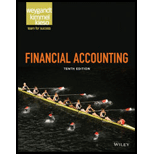
Historical cost principle: The historical cost concept of accounting (cost principle) states that assets should be recorded at its cost (purchased value), not at its fair value while preparing any financial statement because there is no availability of document regarding fair value as evidence for recording, till that item is not sold in the market. Therefore, the fair value of items is not used as the basis for all accounting measurement and reporting.
To Identify: Historical cost concept required adjustments or not.
Want to see the full answer?
Check out a sample textbook solution
Chapter 3 Solutions
Financial Accounting
- Please provide the answer to this financial accounting question using the right approach.arrow_forwardI need help with this general accounting problem using proper accounting guidelines.arrow_forwardI am looking for the correct answer to this general accounting problem using valid accounting standards.arrow_forward
- Solve questionarrow_forwardA company has the following Accounting information for the year: Sales Revenue: $600,000 ⚫ Cost of Goods Sold: $350,000 • • Operating Expenses: $80,000 Interest Expense: $15,000 Tax Rate: 25% What is the company's earnings before taxes (EBT) for the year?arrow_forwardCan you explain the correct methodology to solve this general accounting problem?arrow_forward

 AccountingAccountingISBN:9781337272094Author:WARREN, Carl S., Reeve, James M., Duchac, Jonathan E.Publisher:Cengage Learning,
AccountingAccountingISBN:9781337272094Author:WARREN, Carl S., Reeve, James M., Duchac, Jonathan E.Publisher:Cengage Learning, Accounting Information SystemsAccountingISBN:9781337619202Author:Hall, James A.Publisher:Cengage Learning,
Accounting Information SystemsAccountingISBN:9781337619202Author:Hall, James A.Publisher:Cengage Learning, Horngren's Cost Accounting: A Managerial Emphasis...AccountingISBN:9780134475585Author:Srikant M. Datar, Madhav V. RajanPublisher:PEARSON
Horngren's Cost Accounting: A Managerial Emphasis...AccountingISBN:9780134475585Author:Srikant M. Datar, Madhav V. RajanPublisher:PEARSON Intermediate AccountingAccountingISBN:9781259722660Author:J. David Spiceland, Mark W. Nelson, Wayne M ThomasPublisher:McGraw-Hill Education
Intermediate AccountingAccountingISBN:9781259722660Author:J. David Spiceland, Mark W. Nelson, Wayne M ThomasPublisher:McGraw-Hill Education Financial and Managerial AccountingAccountingISBN:9781259726705Author:John J Wild, Ken W. Shaw, Barbara Chiappetta Fundamental Accounting PrinciplesPublisher:McGraw-Hill Education
Financial and Managerial AccountingAccountingISBN:9781259726705Author:John J Wild, Ken W. Shaw, Barbara Chiappetta Fundamental Accounting PrinciplesPublisher:McGraw-Hill Education





